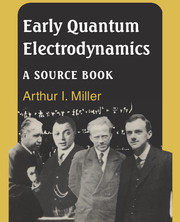Book contents
- Frontmatter
- Contents
- Preface
- Notes to the Preface
- Acknowledgements
- Notes to the Reader
- I Frame-setting essay
- Epilogue
- Notes
- References to the Frame-setting essay
- II Selected papers
- 1 The self-energy of the electron
- 2 Remarks on radiation theory
- 3 Theory of the positron
- 4 Discussion of the infinite distribution of electrons in the theory of the positron
- 5 The self-energy of the electron
- 6 Remarks on the Dirac theory of the positron
- 7 The quantization of the scalar relativistic wave equation
- 8 The electrodynamics of the vacuum based on the quantum theory of the electron
- 9 Theory of the emission of long-wave light quanta
- 10 The universal length appearing in the theory of elementary particles
- 11 The interaction between charged particles and the radiation field
- Index to Frame-setting essay
4 - Discussion of the infinite distribution of electrons in the theory of the positron
Published online by Cambridge University Press: 05 August 2012
- Frontmatter
- Contents
- Preface
- Notes to the Preface
- Acknowledgements
- Notes to the Reader
- I Frame-setting essay
- Epilogue
- Notes
- References to the Frame-setting essay
- II Selected papers
- 1 The self-energy of the electron
- 2 Remarks on radiation theory
- 3 Theory of the positron
- 4 Discussion of the infinite distribution of electrons in the theory of the positron
- 5 The self-energy of the electron
- 6 Remarks on the Dirac theory of the positron
- 7 The quantization of the scalar relativistic wave equation
- 8 The electrodynamics of the vacuum based on the quantum theory of the electron
- 9 Theory of the emission of long-wave light quanta
- 10 The universal length appearing in the theory of elementary particles
- 11 The interaction between charged particles and the radiation field
- Index to Frame-setting essay
Summary
Proceedings of the Cambridge Philosophical Society, 30: 150–63 (1934). Received 2 February 1934.
Use of the density matrix
The quantum theory of the electron allows states of negative kinetic energy as well as the usual states of positive kinetic energy and also allows transitions from one kind of state to the other. Now particles in states of negative kinetic energy are never observed in practice. We can get over this discrepancy between theory and observation by assuming that, in the world as we know it, nearly all the states of negative kinetic energy are occupied, with one electron in each state in accordance with Pauli's exclusion principle, and that the distribution of negative-energy electrons is unobservable to us on account of its uniformity. Any unoccupied negative-energy states would be observable to us, as holes in the distribution of negative-energy electrons, but these holes would appear as particles with positive kinetic energy and thus not as things foreign to all our experience. It seems reasonable and in agreement with all the facts known at present to identify these holes with the recently discovered positrons and thus to obtain a theory of the positron.
We now have a picture of the world in which there are an infinite number of negative-energy electrons (in fact an infinite number per unit volume) having energies extending continuously from −mc2 to −∞. The problem we have to consider is the way this infinity can be handled mathematically and the physical effects it produces.
Information
- Type
- Chapter
- Information
- Early Quantum ElectrodynamicsA Sourcebook, pp. 145 - 156Publisher: Cambridge University PressPrint publication year: 1994
